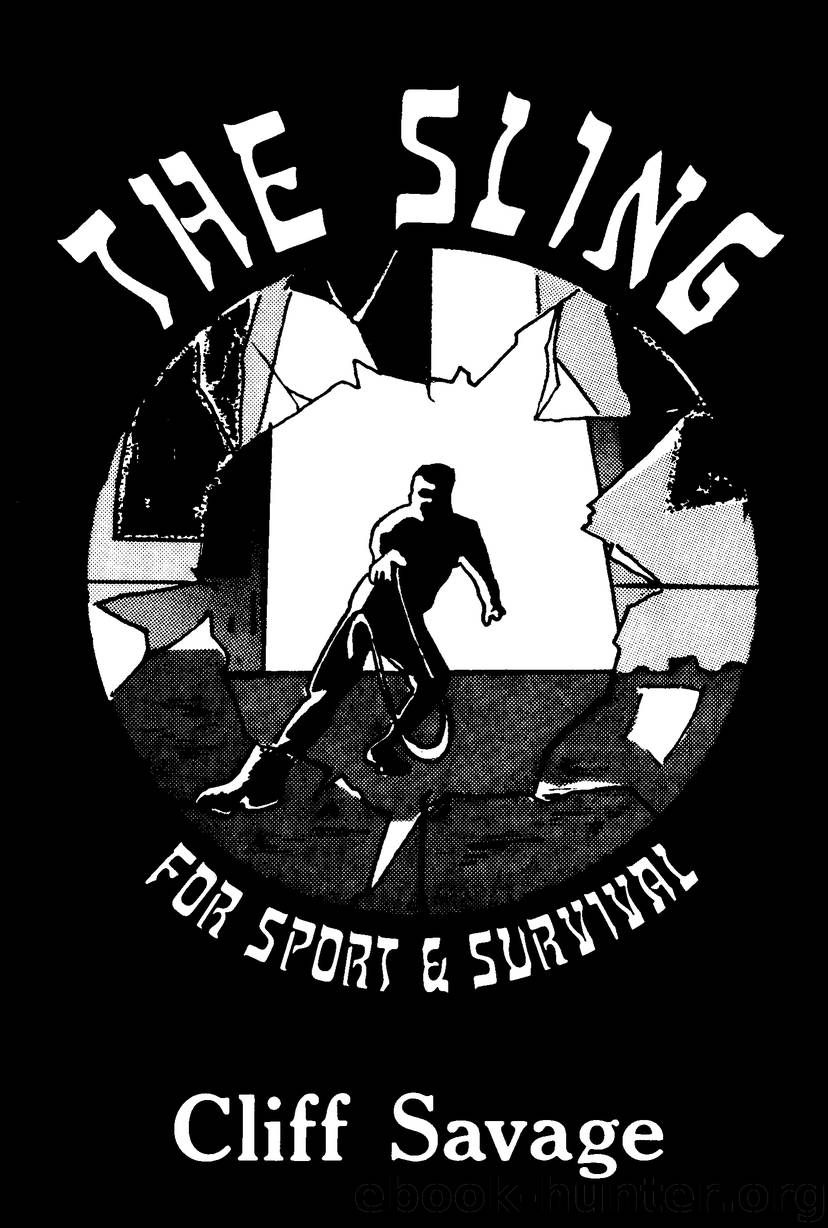The Sling: For Sport and Survival by Cliff Savage

Author:Cliff Savage [Savage, Cliff]
Language: eng
Format: epub
Tags: Sports & Recreation, Martial Arts & Self-Defense, Nonfiction
ISBN: 9781581605655
Google: ZH_wygAACAAJ
Amazon: 158160565X
Goodreads: 14363262
Publisher: Paladin Press
Published: 1983-12-31T23:00:00+00:00
The release
Once you have gotten the sling balanced and up to speed with the wind-up, you are ready to let your stone fly. The release stroke is just like a wind-up stroke, only more powerful. You really put everything you’ve got into the last rotation, and drop the release cord at precisely the right moment. It will take some practice time before you can accurately hurl the proper distance in the correct direction. But you will see that improvement is fast to come—and fulfilling.
Your throwing arm and shoulder come more into play when you are ready to release the sling. On the final wind-up rotation, your upper arm moves backward and your shoulder rises up. With your elbow sticking out behind you, whip the sling around its last ark and let it fly!
During the release stroke, your weight moves first from your left foot back onto your right foot. As you let the stone go, all of your weight then moves forward onto your front-foot again. This shifting of weight is very similar to that of the baseball player as he delivers the pitch. When all your weight moves forward as you deliver your shot, your back foot will naturally lift off the ground slightly and move forward with your momentum (see the illustration of the overhand hurl). In this way, the maximum force is packed into your shot. Watch as the stone soars toward its target!
At the moment of release, the stone will continue its motion, traveling in a line tangent to the circle of rotation. For example, using the underhand throw, the wind-up will be clockwise. If the sling is released at six o’clock (the lowest point of rotation) it will travel straight forward. Released at nine o’clock, it will fly straight up. At twelve o’clock, the liberated stone will fly backwards.
An understanding of which direction the stone will fly is crucial to developing your aim. As we shall see when examining the different hurling styles, knowing the proper moment to release the sling is a tricky matter. Fortunately, this understanding comes easily with practice.
Let’s recap what we’ve learned about the basic hurl. First limber up and relax before you start practicing. Find a stone and get into the proper stance: left foot forward, right foot pointing to the side. Load the sling and let it drop to your side. Start rotating the sling, using your wrist to do all the work. After a couple rotations, lean back, whip the sling around for the last time with a powerful jerk of the arm, then let the stone fly when the sling is in the right position. Now that you know the fundamental of slinging, we’ll go on to look at the different types of throws you can use. Some of them are easy to learn, while others will require many hours of practice to master. All of them are fun!
Download
This site does not store any files on its server. We only index and link to content provided by other sites. Please contact the content providers to delete copyright contents if any and email us, we'll remove relevant links or contents immediately.
Backpacker the Complete Guide to Backpacking by Backpacker Magazine(1823)
The Isle of Mull by Terry Marsh(1522)
Capital in the Twenty-First Century by Thomas Piketty(1423)
Predation ID Manual by Kurt Alt(1314)
The Collected Non-Fiction by George Orwell(1308)
Small-Bore Rifles by C. Rodney James(1274)
Creative Confidence by Tom Kelley(1144)
Backcountry Bear Basics by Dave Smith(1132)
All Fishermen Are Liars by John Gierach(1119)
50 Famous Firearms You've Got to Own by Rick Hacker(1107)
Blood Mountain by J.T. Warren(1098)
The Art of Throwing by Amante P. Marinas Sr(1080)
Archery: The Art of Repetition by Simon Needham(1066)
Long Distance Walking in Britain by Damian Hall(1055)
Backpacker Long Trails by Backpacker Magazine(1034)
The Fair Chase by Philip Dray(982)
The Ultimate Shooting Skills Manual: 212 Essential Range and Field Skills (Outdoor Life) by The Editors of Outdoor Life(968)
The Real Wolf by Ted B. Lyon & Will N. Graves(960)
The Ultimate Guide to Home Butchering by Monte Burch(950)
